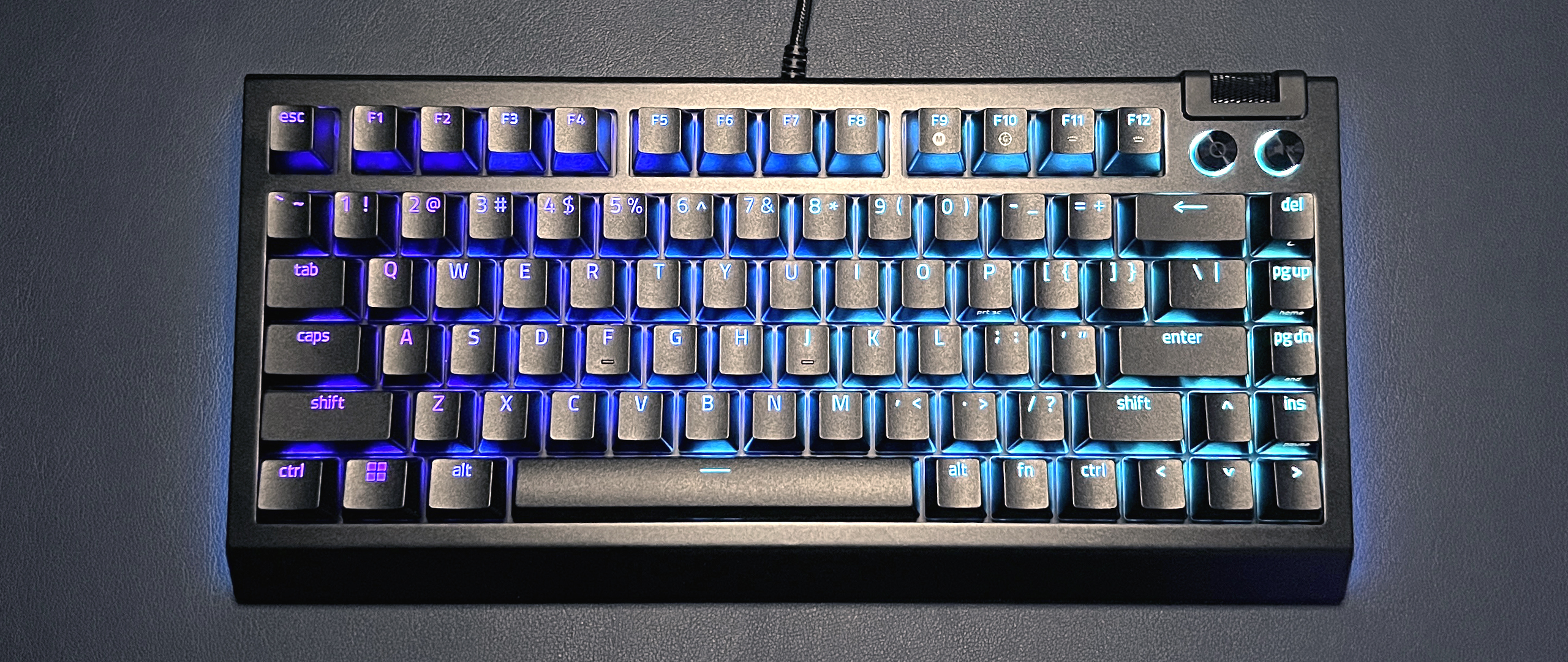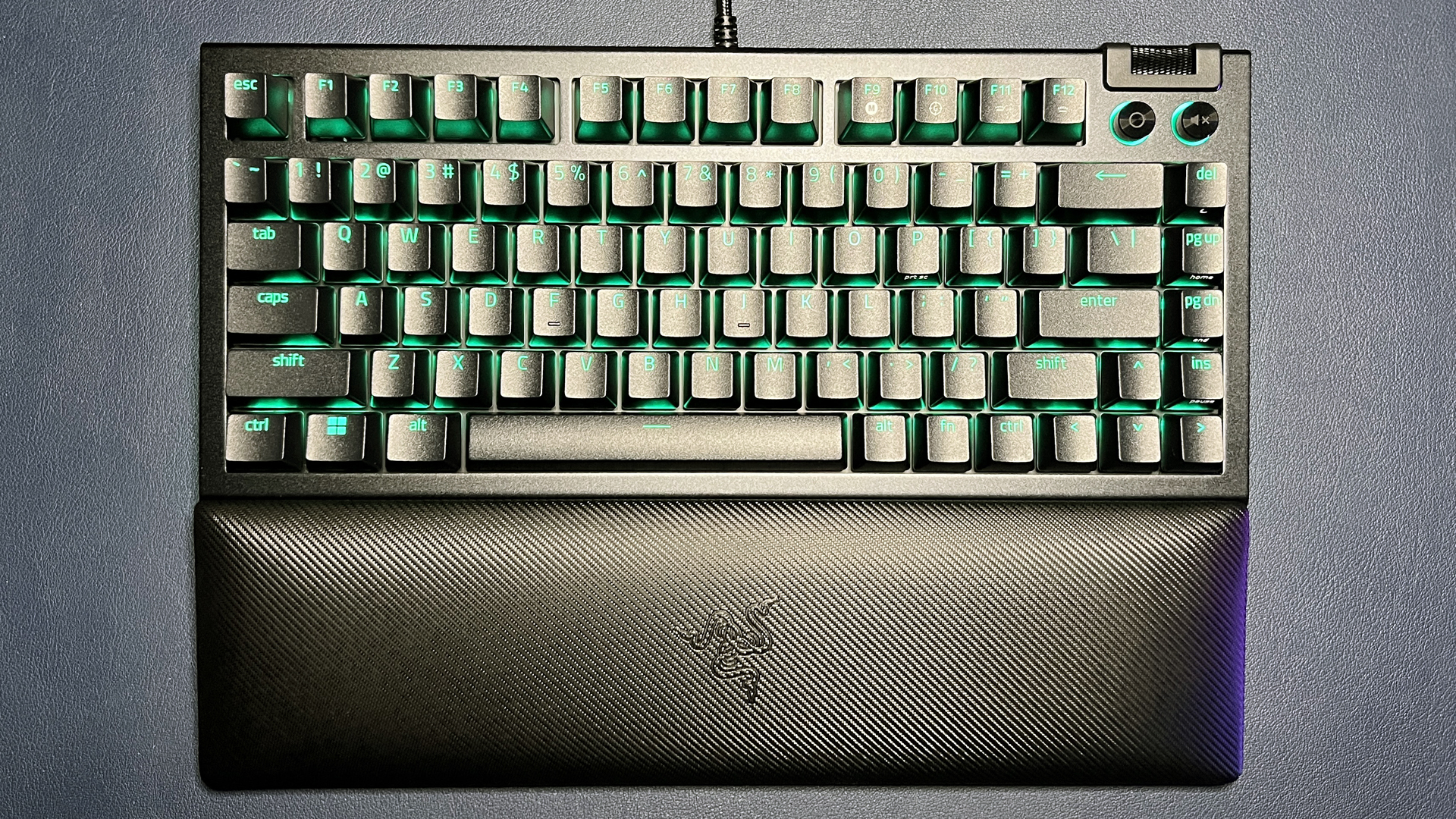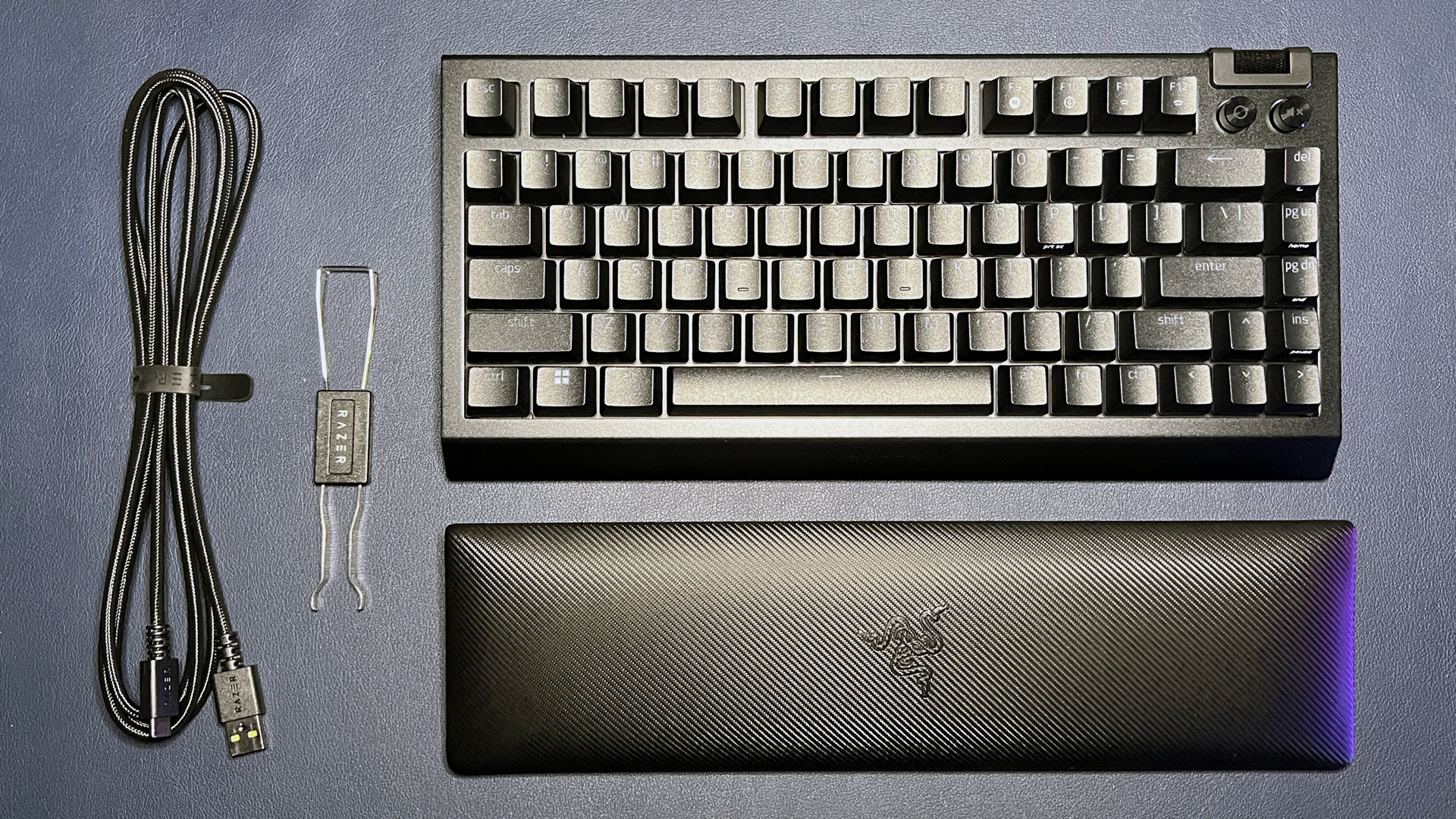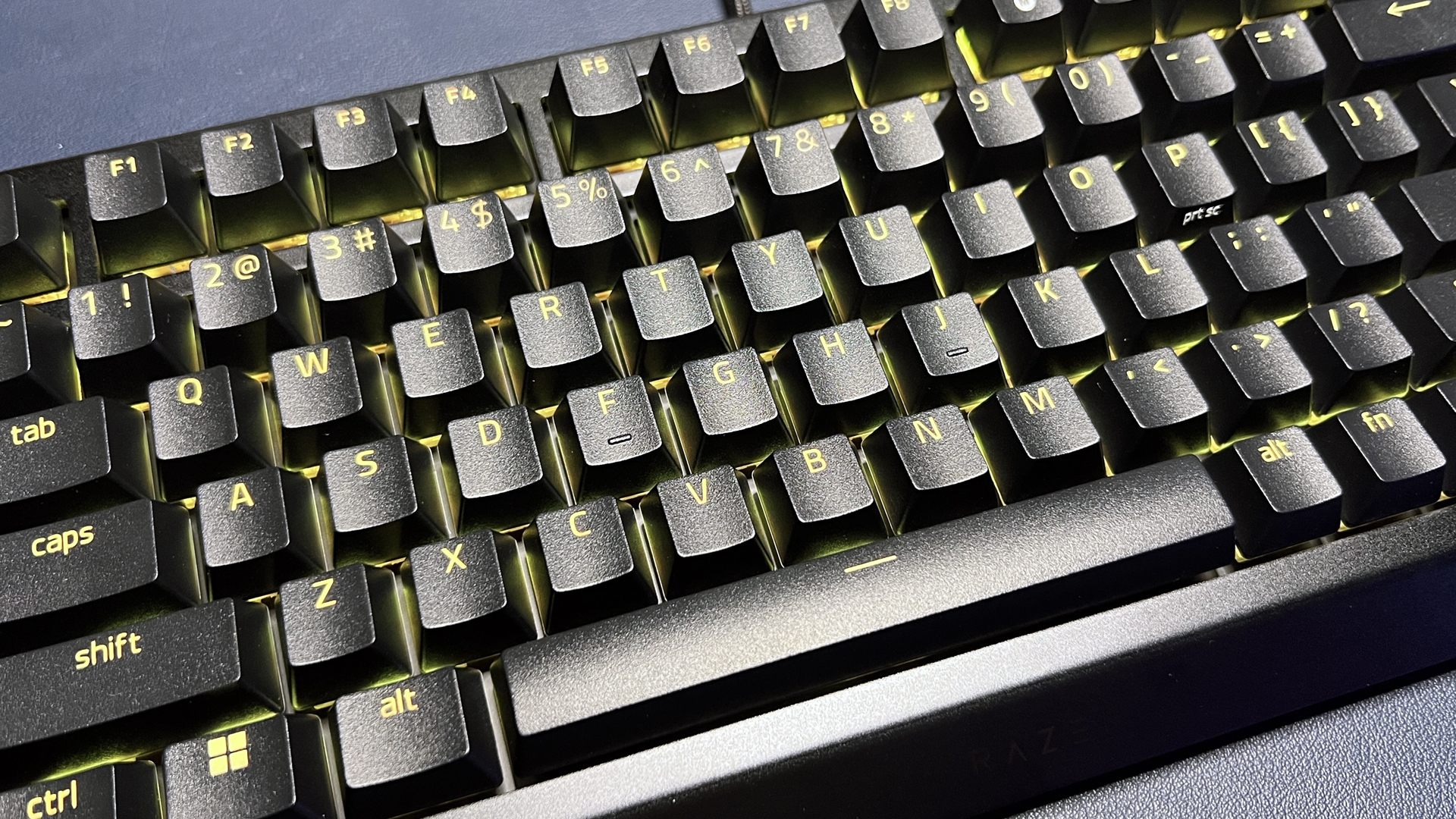Tom's Hardware Verdict
Razer’s first hot-swappable keyboard sounds great, even if it looks a little boring.
Pros
- +
Sounds much better than Razer’s other keyboards
- +
Hot-swappable PCB compatible with 3- and 5-pin switches
- +
Up to 8,000 Hz polling rate
Cons
- -
Kind of boring overall
- -
Media keys only semi-programmable
- -
Some stabilizer rattle
Why you can trust Tom's Hardware
It seems like 2023 is the year gaming companies have decided to get serious about keyboard customizability — physical customizability, that is. The Razer BlackWidow V4 75% may not look like anything out of the ordinary (in fact, it looks almost exactly like a smaller version of the BlackWidow V4 Pro), but this is actually Razer’s first hot-swappable gaming keyboard.
The BlackWidow V4 75% is a wired mechanical gaming keyboard with a compact 75-percent layout and a detachable, padded leatherette wrist rest. For the keyboard enthusiasts it has an aluminum top plate, a hot-swappable PCB, and a gasket-mounted design with two layers of sound-dampening foam, and for the gamers it has N-key rollover, polling rates of up to 8,000 Hz, and bright, customizable per-key RGB (with side underglow).
The BlackWidow V4 75% is available now in black, with Razer’s orange tactile switches, for $189.99. A white version will be released in mid-September, and will cost an extra $10 ($199.99). Razer is also selling standalone 36-packs of its mechanical switches (orange/tactile, green/clicky, yellow/linear) for $24.99 each, but the keyboard will only come with orange switches installed.
Design and Construction of the BlackWidow V4 75%
At a glance, the BlackWidow V4 75% looks like a smaller version of the BlackWidow V4 Pro — wrist rest and all. It doesn’t have the V4 Pro’s triple-side underglow, nor does its underglow extend to the wrist rest when connected, but otherwise the new V4 75% shares a very similar overall design, housed in a sturdy black ABS plastic chassis with a matte black aluminum alloy top plate, and machined metal media keys/roller.
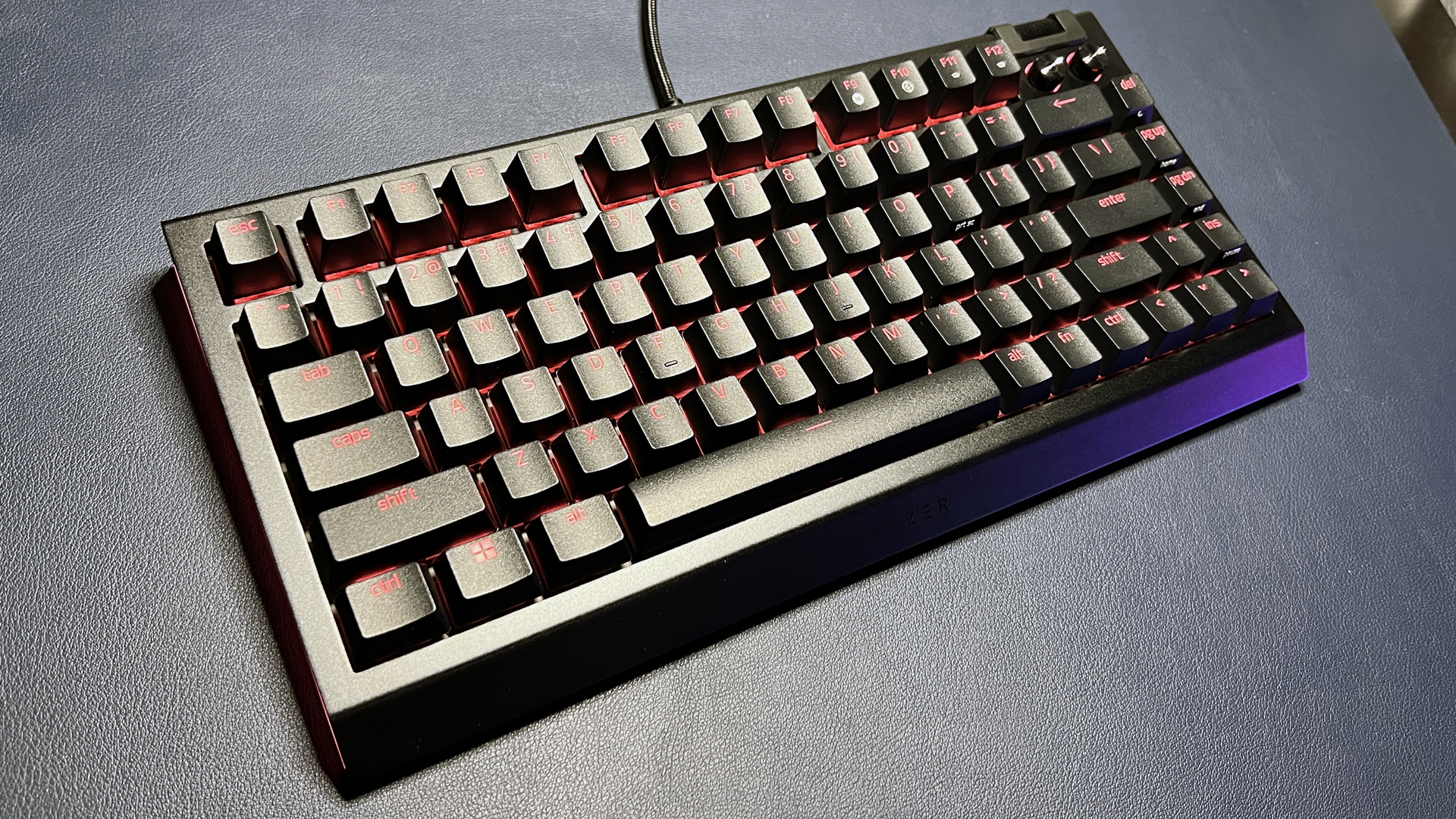
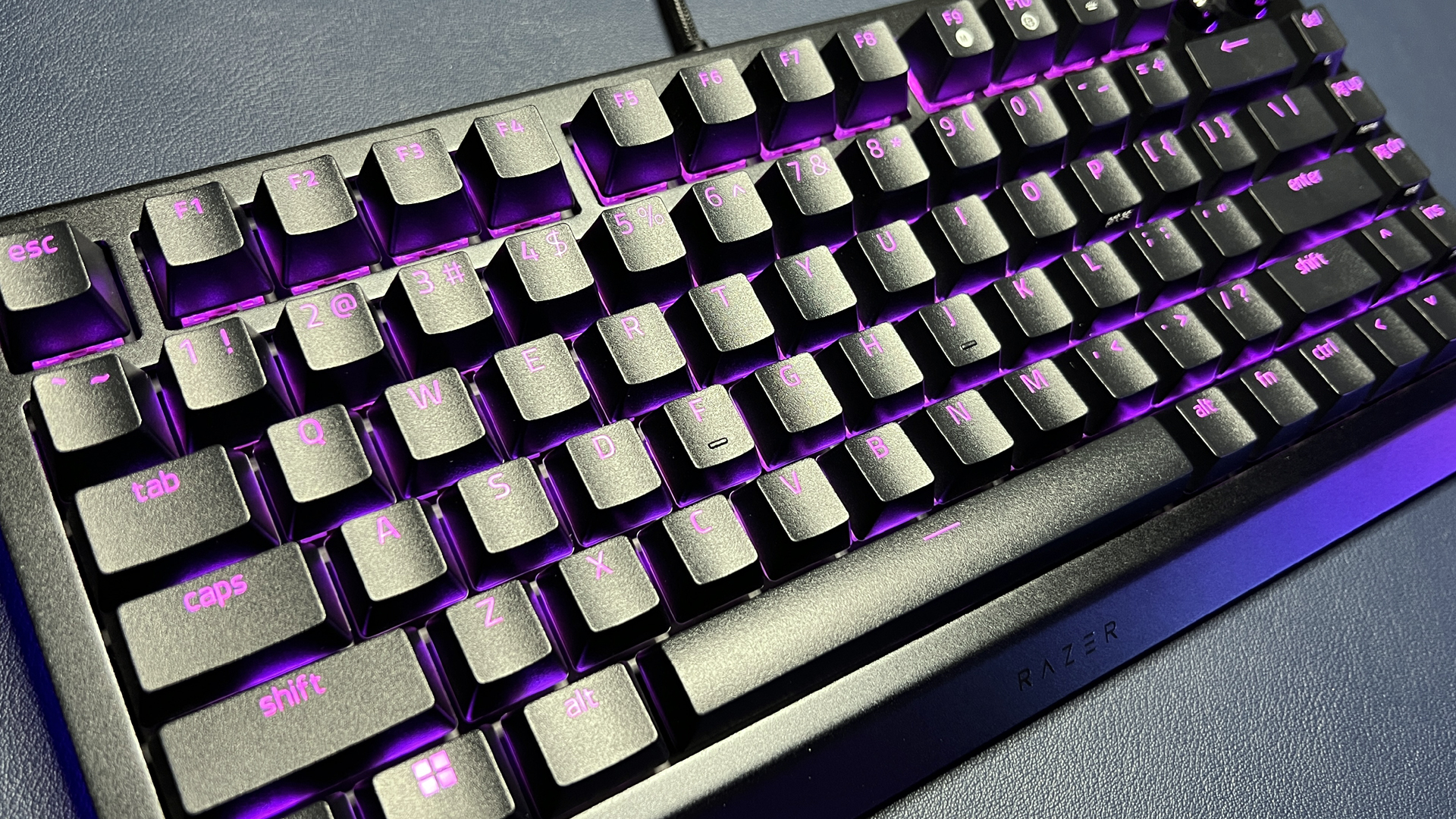
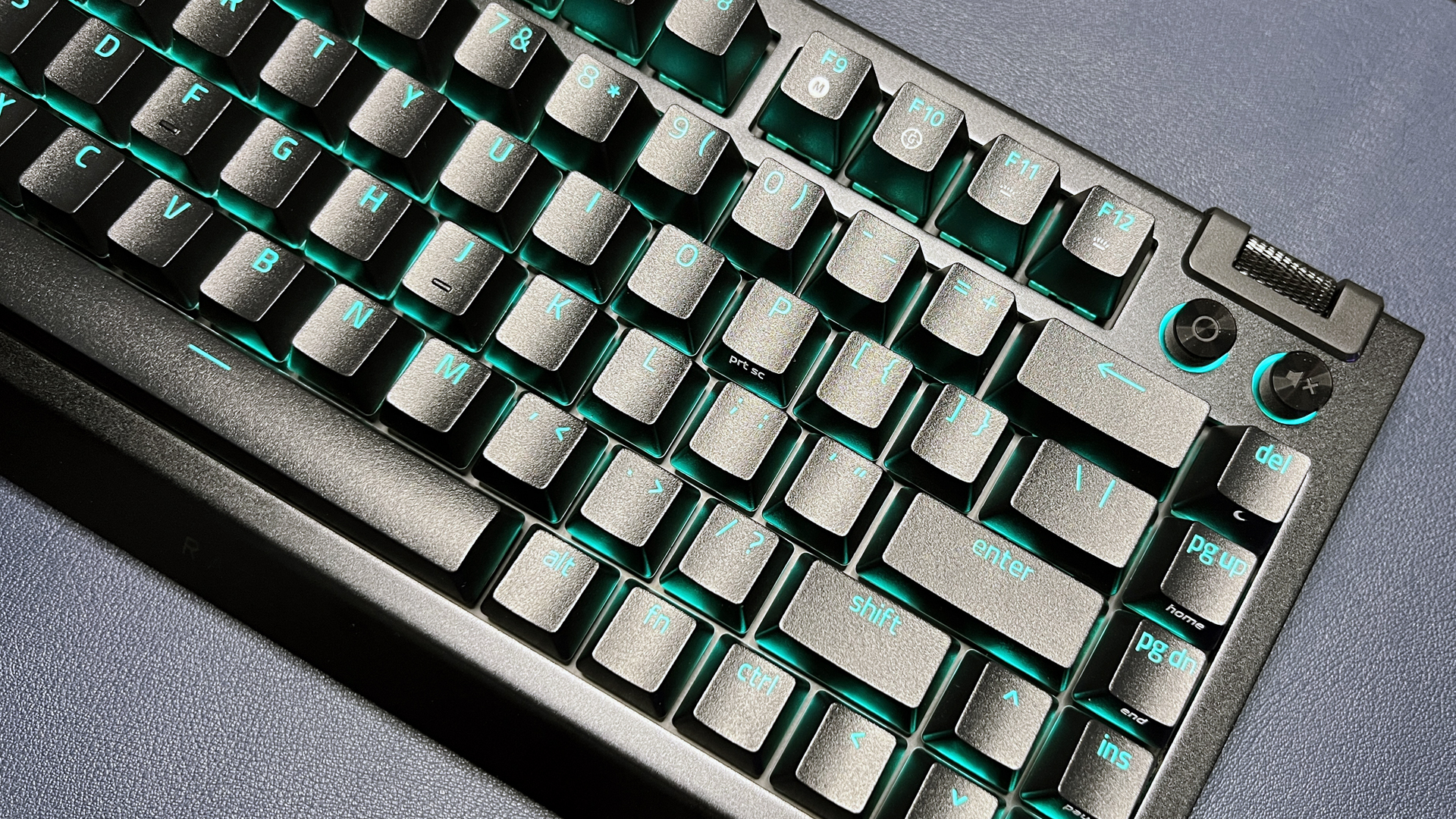
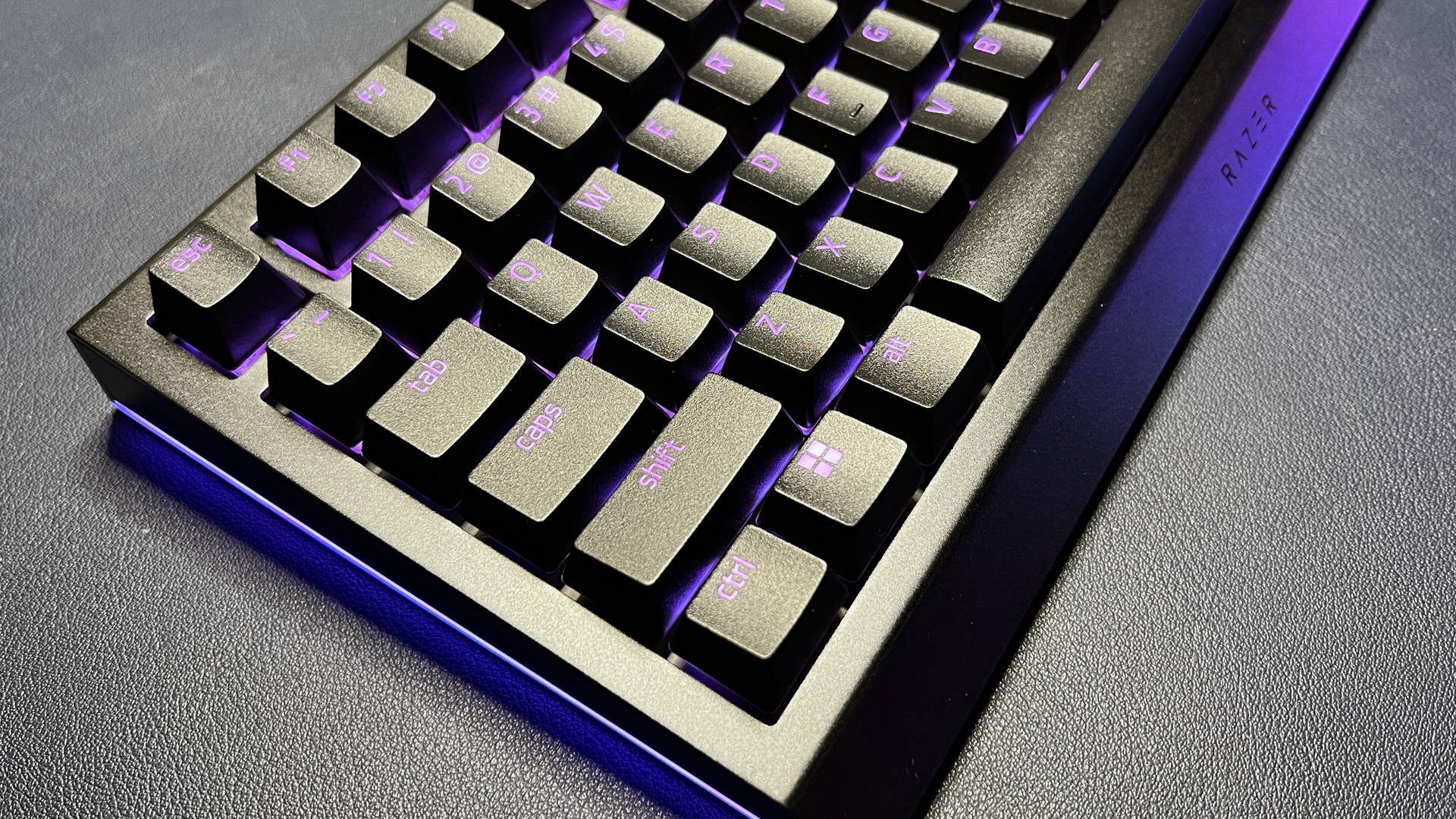
The BlackWidow V4 75% has a compact 75-percent layout, which is slightly smaller than a TKL layout, with a single column of four navigation keys (versus the TKL’s three-column, two-row cluster of six). While many 75-percent keyboards leave some space between the main keys, arrow keys, and navigation keys, the V4 75% does not — the navigation keys and arrow keys are right next to the main keys. This shaves off a few millimeters from the keyboard’s overall length: the BlackWidow V4 75% measures 12.6 inches (321mm) long, versus Asus ROG Azoth’s length of 12.83 inches (326mm). It’s a bit wider than other keyboards — 6.1 inches (155.5mm), thanks to a slope at the bottom that allows the wrist rest to nestle up against it.
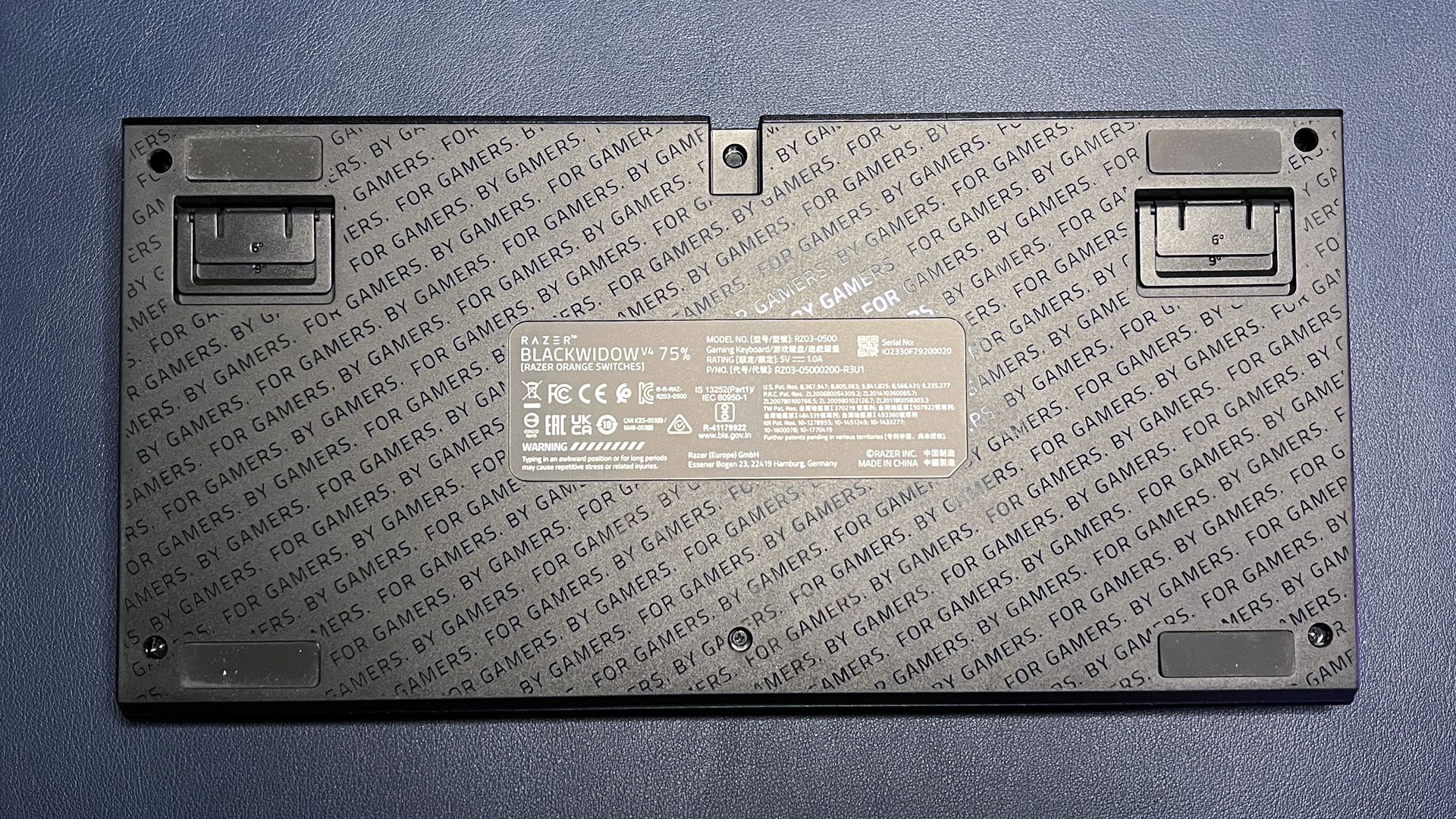
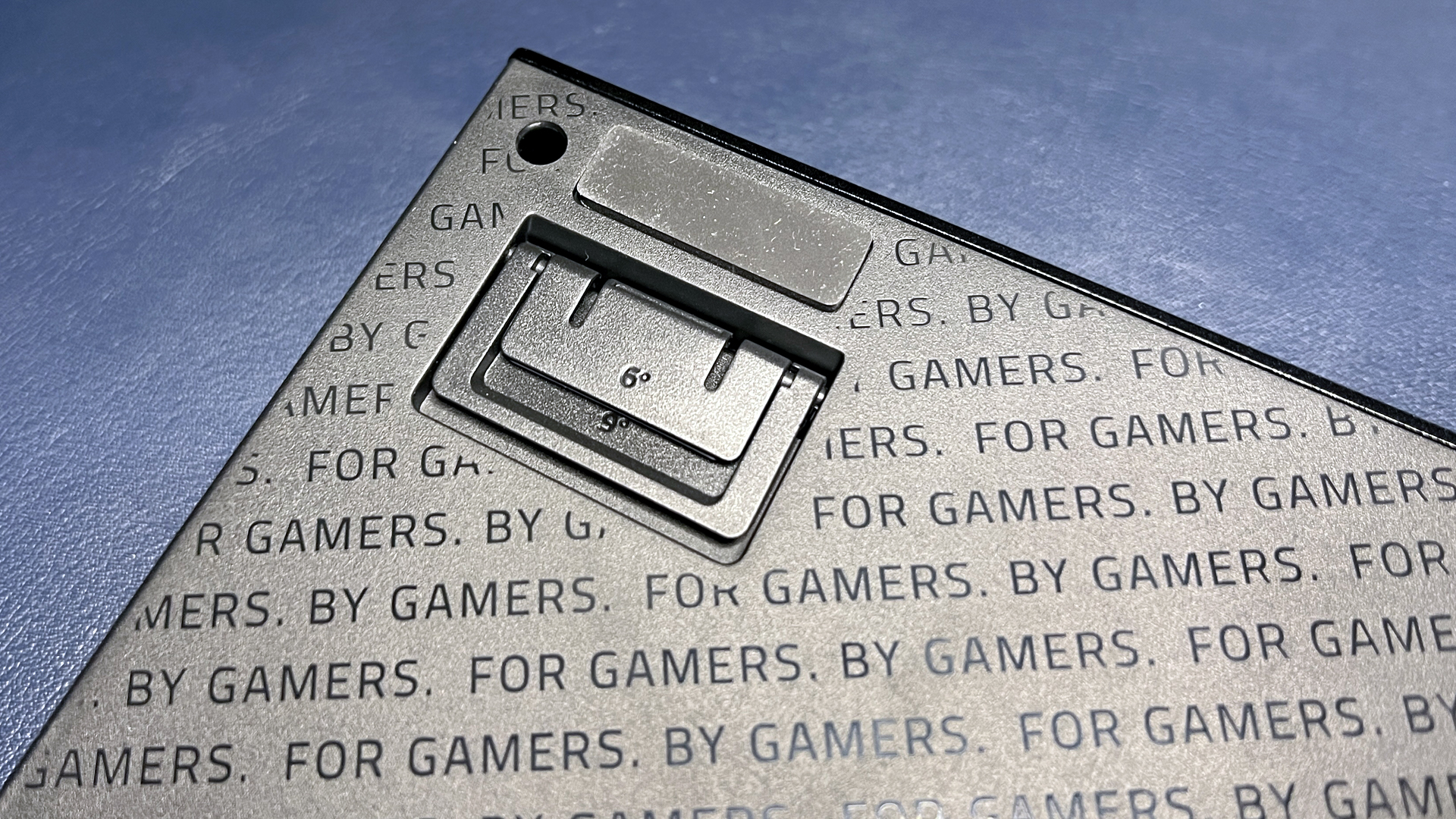
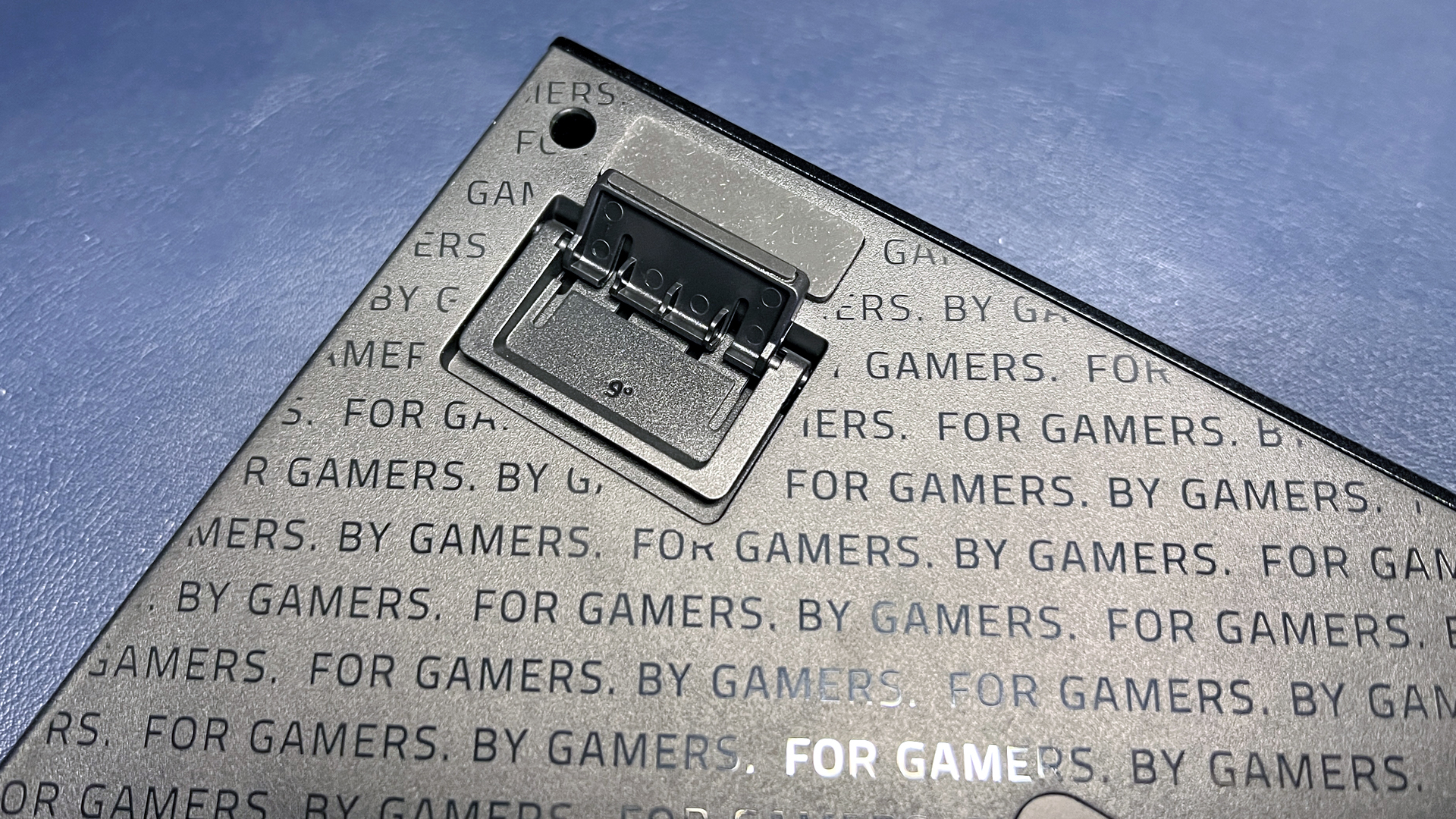
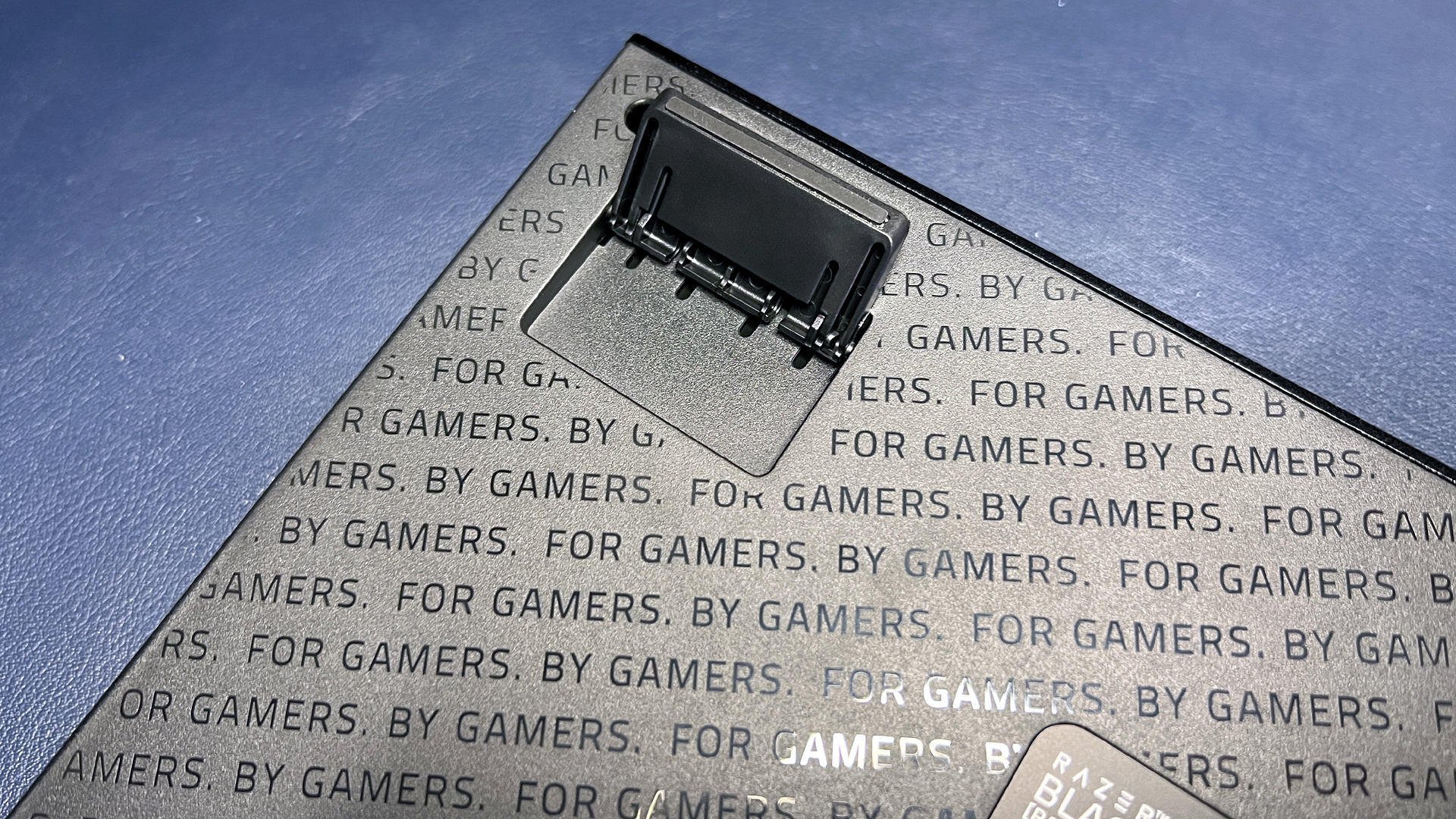
It’s sturdily constructed but not overly heavy, weighting 1.8lbs (815g) — not nearly as heavy as the Azoth (2.61lbs / 1186g), but a little heavier than the SteelSeries Apex Pro TKL Wireless (1.65lbs / 747g). On the bottom, you’ll find four rubber non-slip grips and two sets of flip-out feet, which add an extra 6 degrees or 9 degrees of height to the back of the keyboard.
The BlackWidow V4 75% comes with Razer’s doubleshot ABS keycaps, which are full-height, lightly textured, and have shine-through primary legends and printed (white) secondary legends. While I had no issues with the keycaps in my testing, I’ve found that Razer’s ABS keycaps tend to start showing wear within the first few months of use.
Get Tom's Hardware's best news and in-depth reviews, straight to your inbox.
I’ve been using the BlackWidow V4 Pro intermittently since it launched six months ago, and several of the keycaps are already shiny from wear. While shininess is something that tends to come pretty quickly on ABS keycaps, it seems to come quicker on Razer’s.
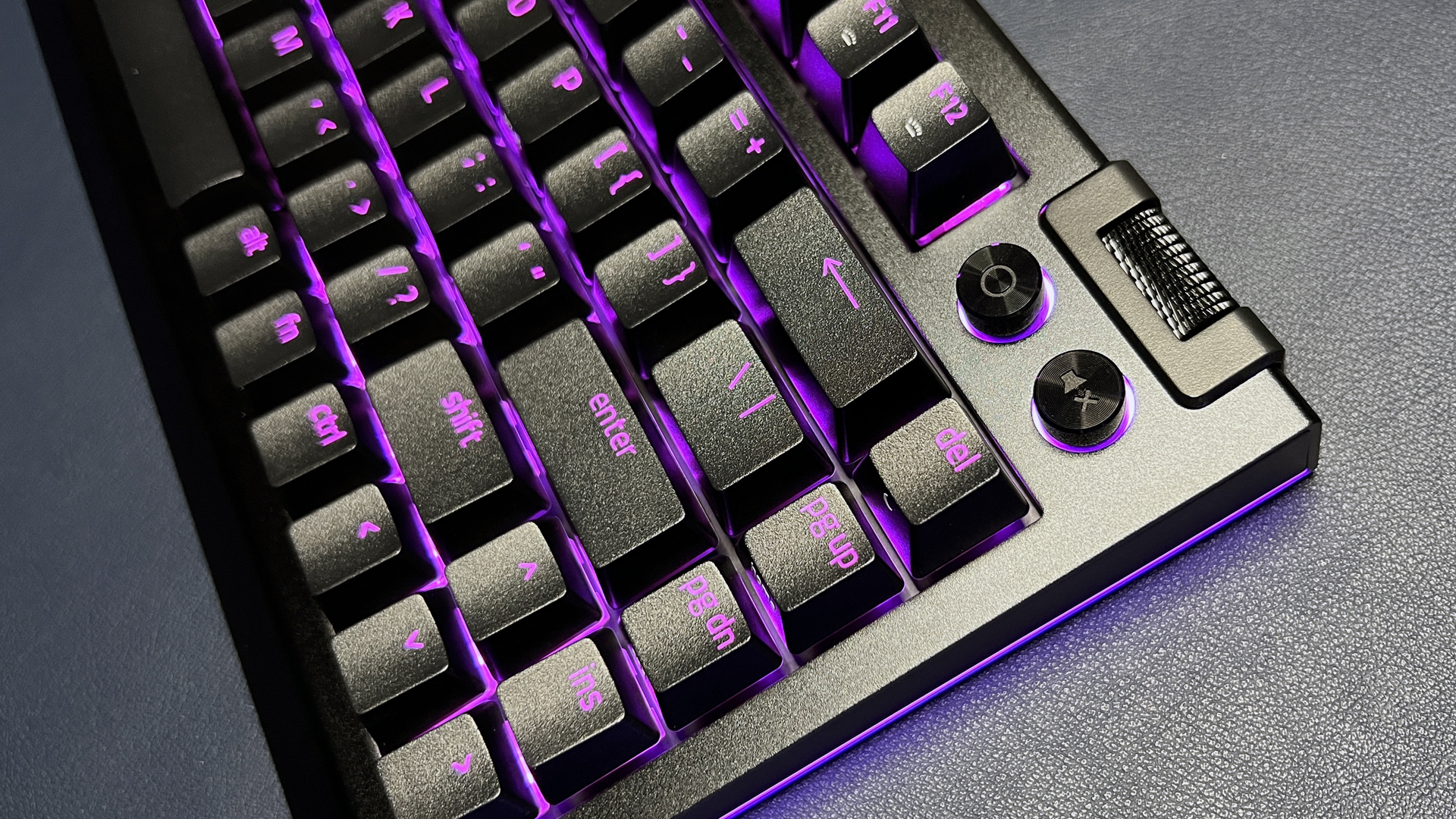
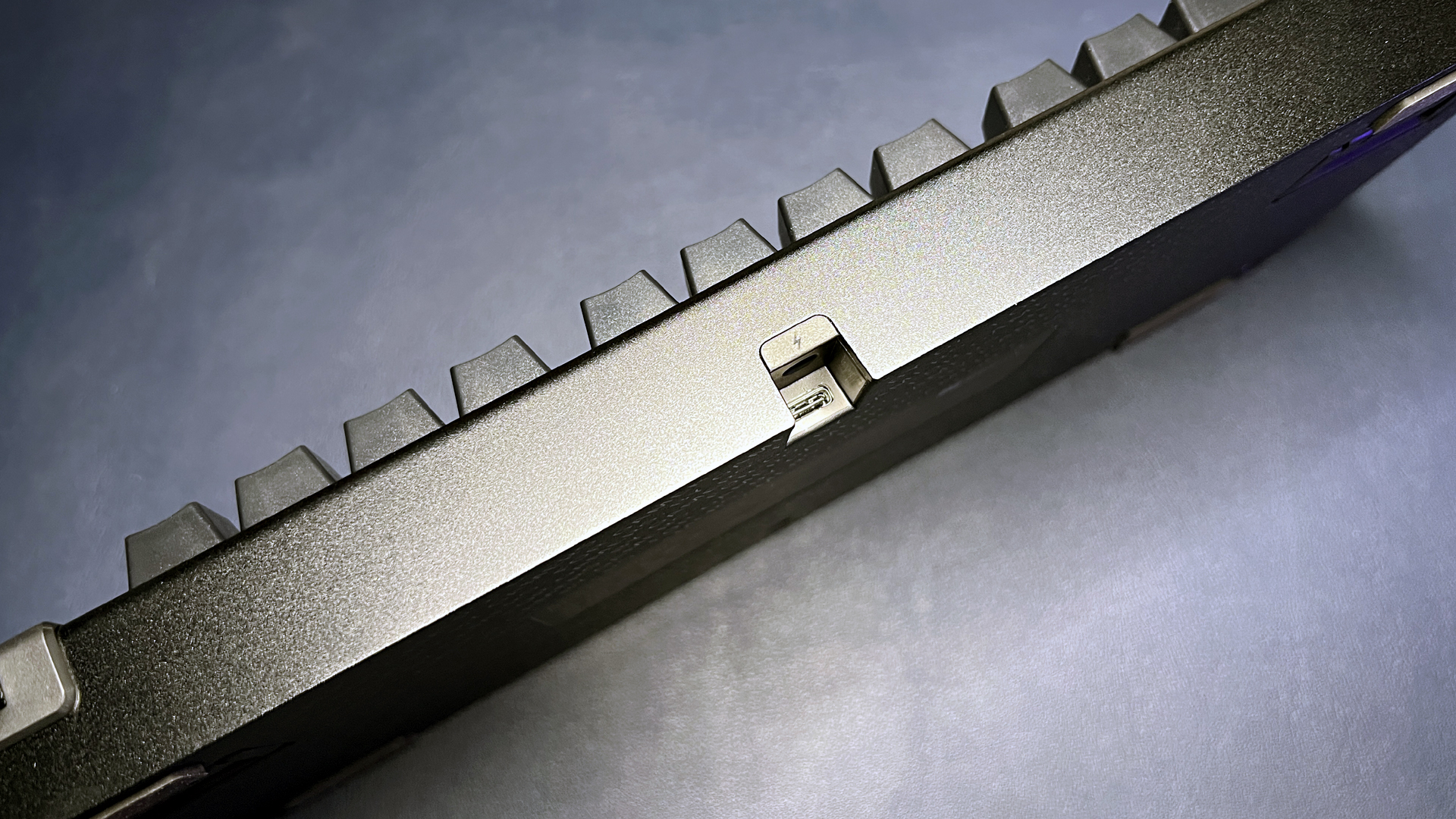
In the upper right corner, the BlackWidow V4 75% features a volume roller and two media keys, all made of machined metal. Interestingly, the right media key, which has a mute symbol etched into it, can be reprogrammed using Razer’s Synapse 3 software. But the left media key, which has a generic circle etched into it, cannot be reprogrammed — this media key is set to play/pause on a single tap, skip to the next track on a double-tap, and go back to the previous track on a triple-tap.
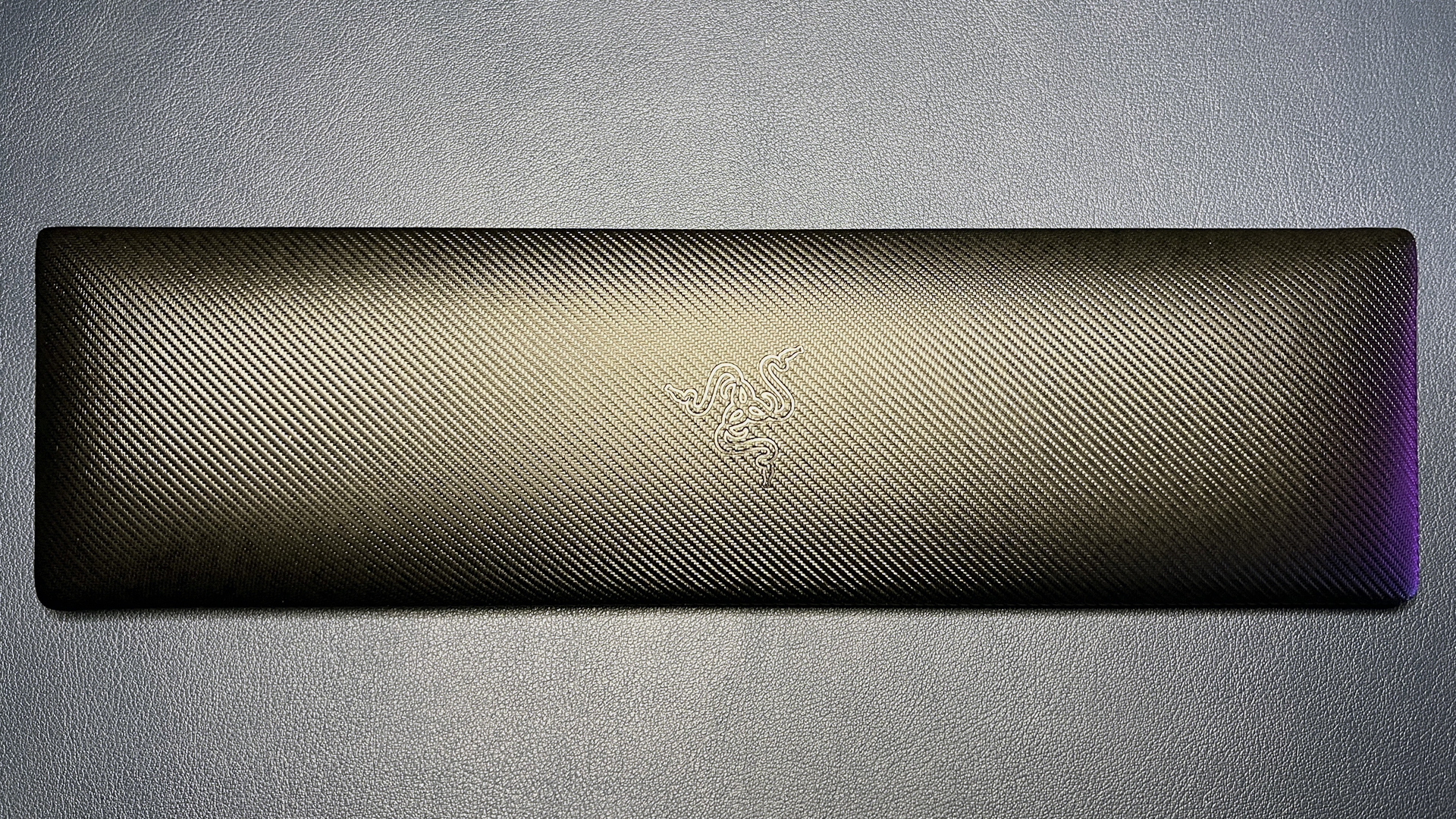
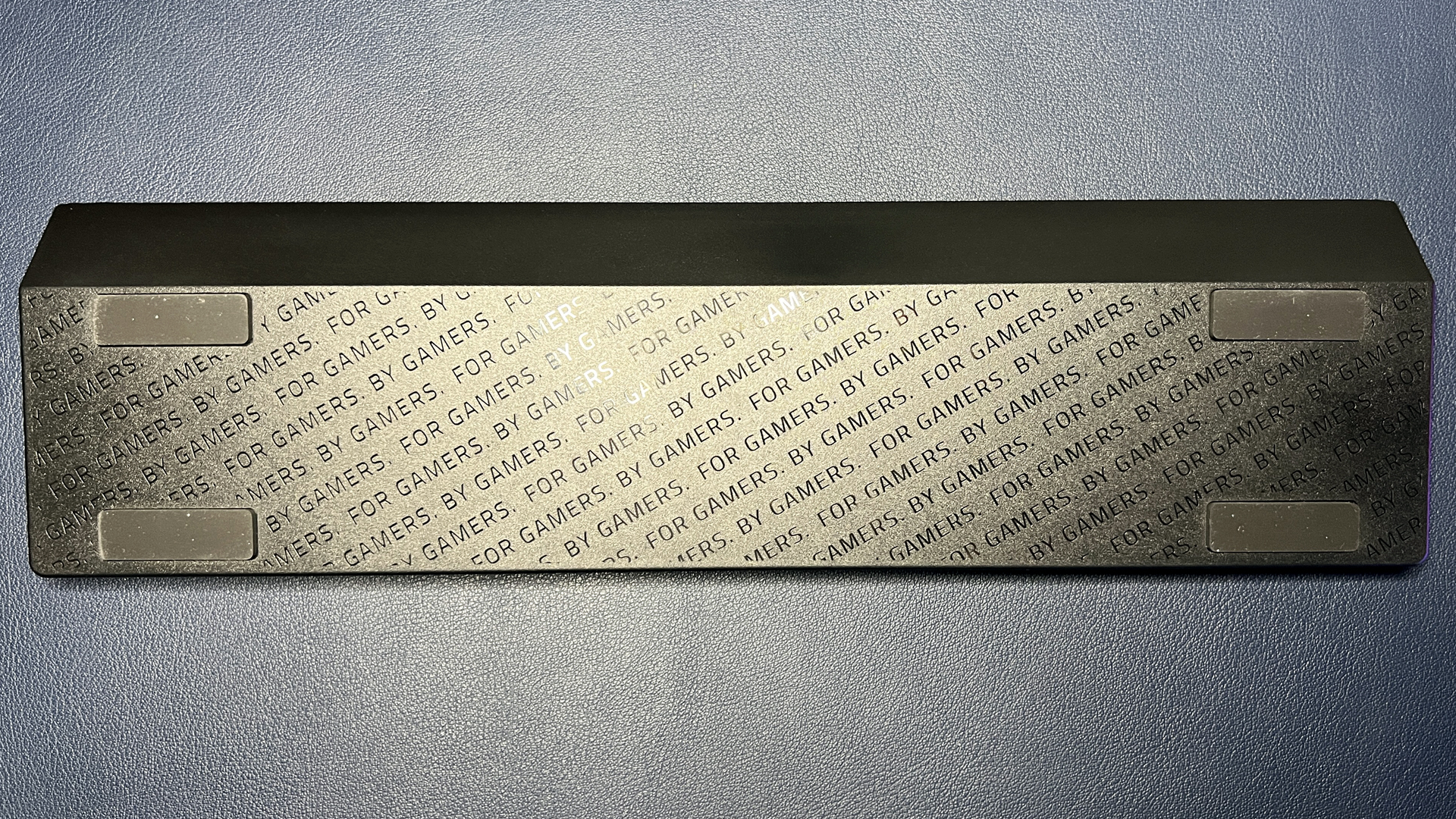
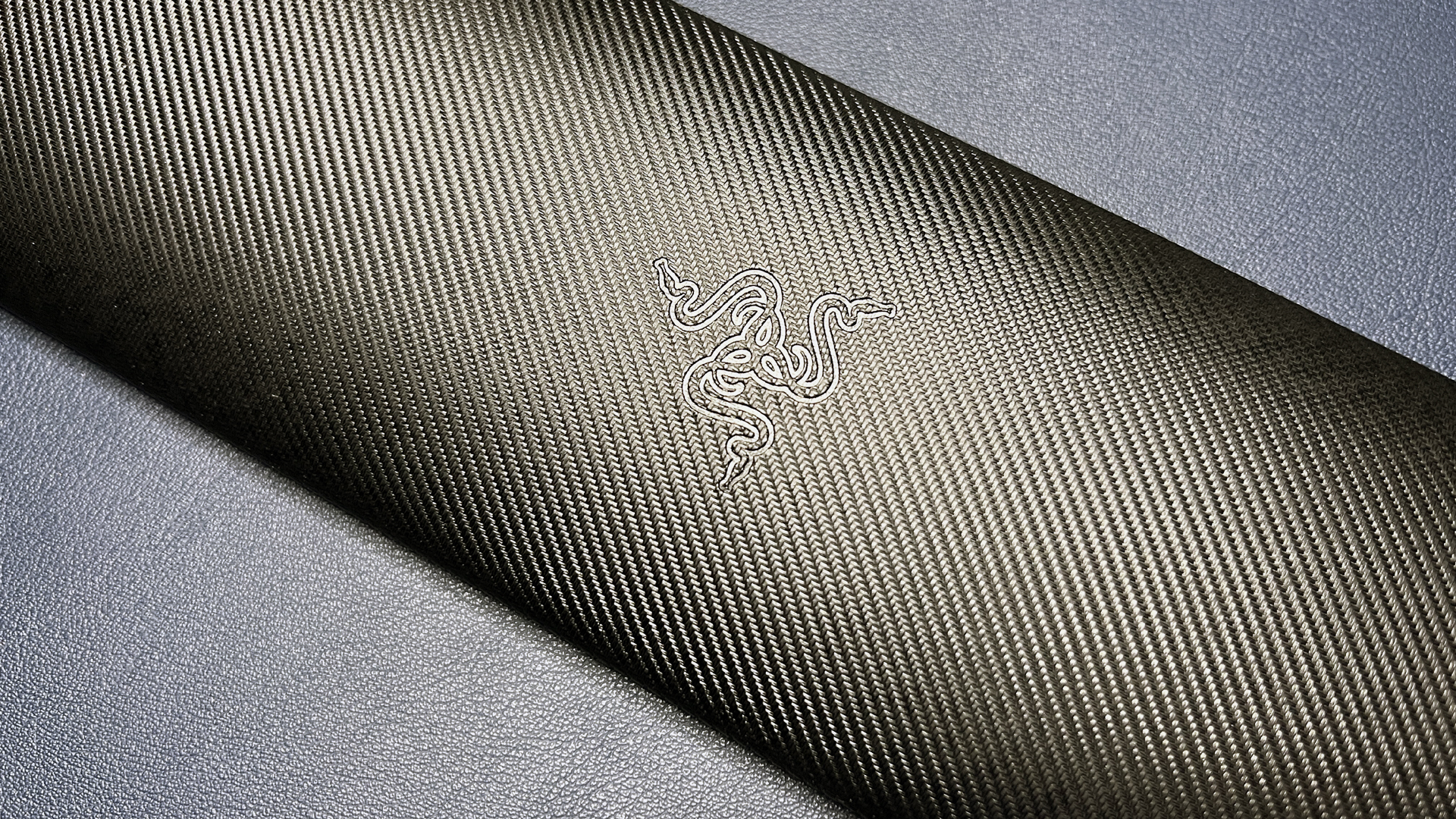
The BlackWidow V4 75% comes with a detachable magnetic leatherette wrist rest, which is padded and has a woven-textured surface. The wrist rest looks like a smaller version of the one that comes with the BlackWidow V4 Pro, but simpler — it doesn’t have a connection point to transfer the keyboard’s underglow, because the V4 75% doesn’t have full underglow (it has underglow on either side, but not along the bottom).
Also in the box: a 6.5-foot (2m) detachable USB-C to USB-A cable, and a combination keycap/switch puller.
Specs
| Switches | Razer Orange (Tactile) |
| Lighting | Per-key RGB, underglow (sides) |
| Onboard Storage | Yes (5 profiles) |
| Media Keys | Yes, volume roller |
| Game Mode | Yes |
| Connectivity | USB-C |
| Additional Ports | 0 |
| Keycaps | Double-shot ABS |
| Construction | Aluminum top plate |
| Software | Synapse 3 |
| Dimensions (LxWxH) | 12.6 x 6.1 x 0.94 inches / 321 x 155.5 x 24mm |
| Weight | 1.8lbs / 815g |
| MSRP / Price at Time of Review | $189.99 / $189.99 |
| Release Date | Aug. 17, 2023 |
Typing and Gaming Experience on the BlackWidow V4 75%
The BlackWidow V4 75% is a wired 75-percent gaming keyboard with N-key rollover, a polling rate of up to 8,000 Hz, and Razer’s third-gen orange tactile mechanical switches. In a bid to appeal to the keyboard enthusiast side of gamers, the V4 75% also features a tape-enhanced hot-swappable PCB (which accepts both 3- and 5-pin switches) and a gasket-mounted design with two layers of dampening foam.
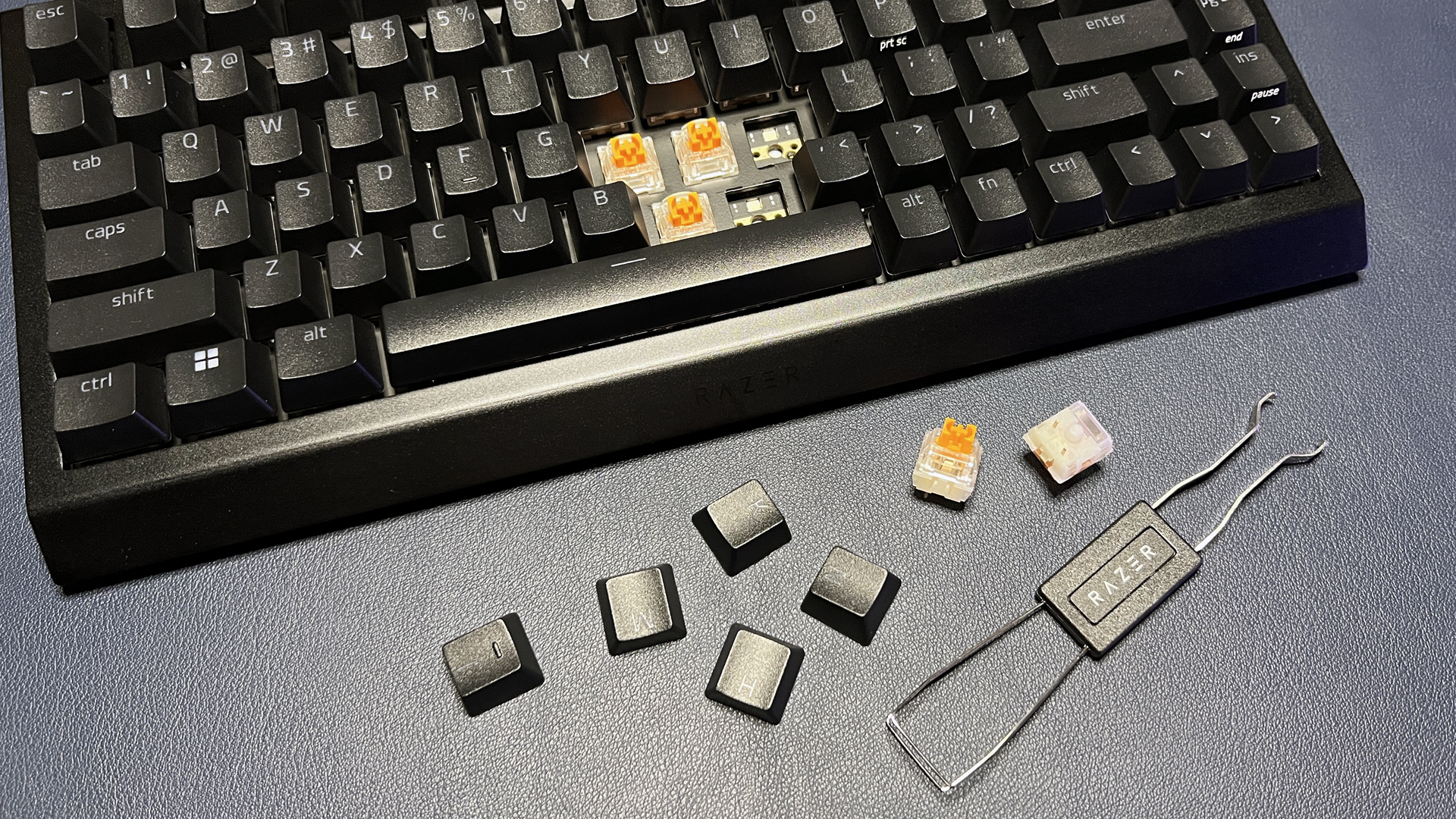
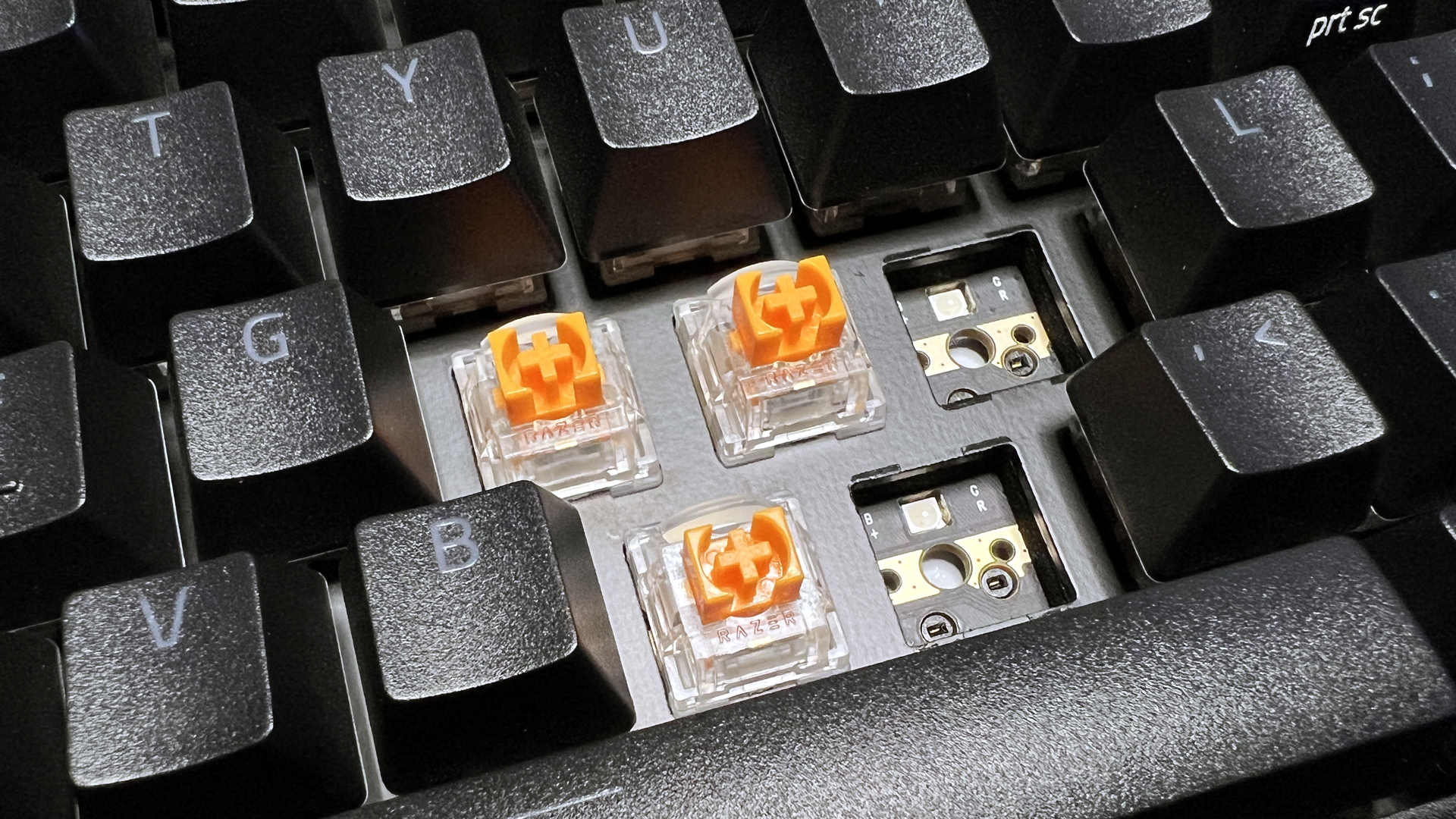
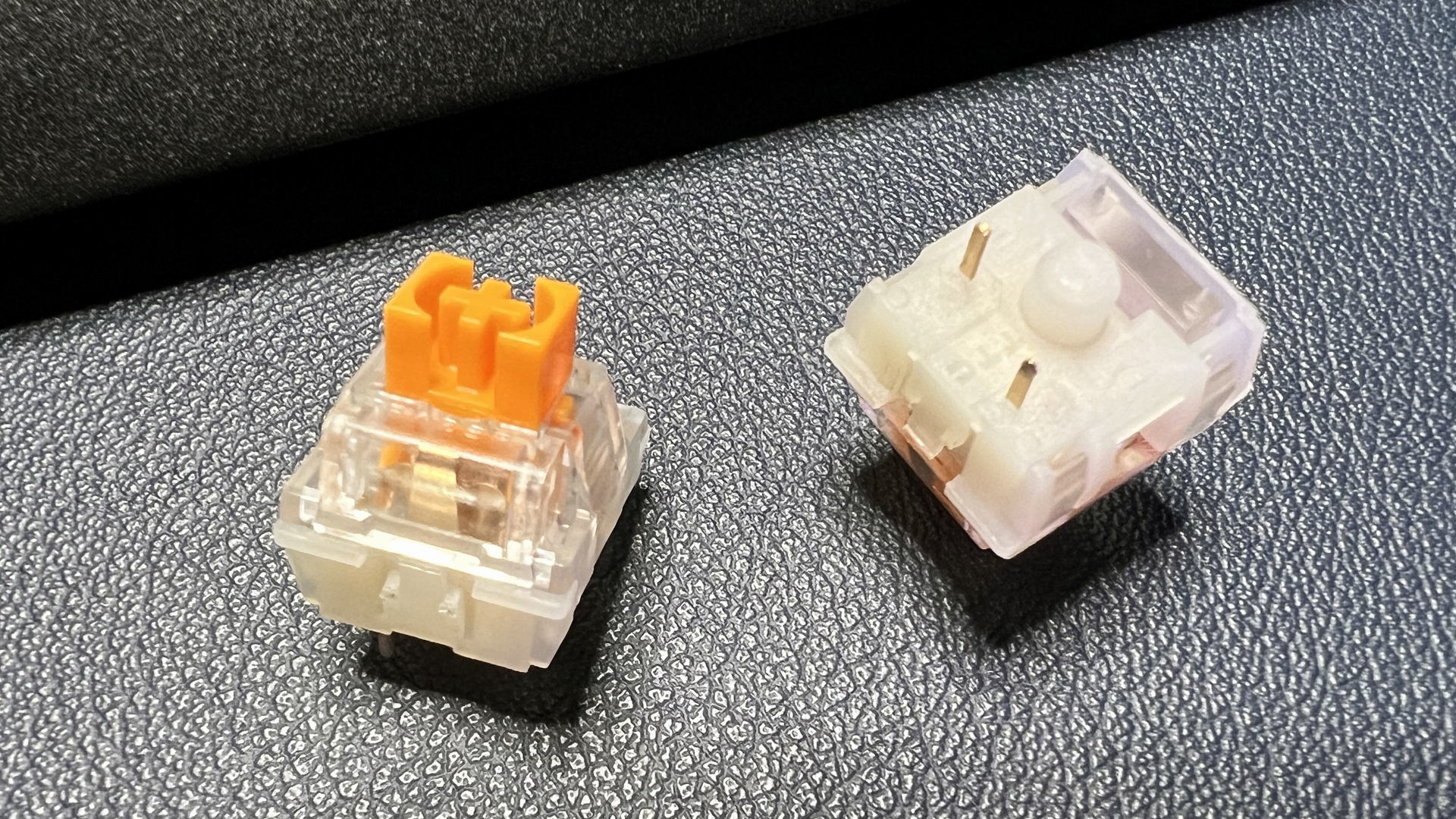
The BlackWidow V4 75% comes with Razer’s third-gen orange tactile mechanical switches, which have an actuation force of 50g, an actuation point of 2mm, and a full travel distance of 3.5mm. These switches have a mild tactile bump but are relatively quiet otherwise, and feel similar to Cherry MX Brown switches — albeit slightly heavier, as the MX Browns have an actuation force of 45g. Razer’s switches are rated for 100 million keystrokes and have a box-style cross stem that’s compatible with most third-party keycaps.
Typing on the BlackWidow V4 75% felt and sounded better than expected — especially if you’re coming from a mainstream gaming keyboard (such as any of Razer’s previous keyboards). The tactile switches combined with the gasket-mounted FR4 plate made for a springy-but-quiet typing experience, even if Razer’s orange switches (and all of Razer’s switches) are slightly stiffer than I prefer. The V4 75% and the V4 Pro sound vastly different — and the V4 Pro doesn’t sound terrible, but you can absolutely hear the tape-modding and sound-dampening foam at work in the V4 75%.
That said, is it the best-sounding keyboard I’ve used recently? Not exactly. I definitely noticed some stabilizer rattle — not in the spacebar, so much, but in the enter and backspace keys — despite the V4 75%’s factory-lubed, plate-mounted stabilizers. But that’s pretty nit-picky; overall, the V4 75% sounds better than 99% of mainstream gaming keyboards on the market.
As for gaming, the BlackWidow V4 75% performed — as expected — very well, with no latency or lag, though the orange switches’ tactile bump and slightly-heavier actuation force may start to fatigue your fingers if you’re used to smooth, lightweight linear optical switches.
The keyboard has a default polling rate of 1,000 Hz, but you can bump this up to 8,000 Hz in Razer’s Synapse 3 software. This is a wired keyboard so there’s no concern about a higher polling rate eating up battery life, but it does use more processing power and Razer warns that an 8,000 Hz polling rate “may result in reduced frame rate when playing CPU bound games.” I didn’t notice any reduced frame rates in my testing, and I’ve mostly been playing Baldur’s Gate 3, which is CPU-heavy.
Features and Software of the BlackWidow V4 75%
The BlackWidow V4 75% works well out of the box, but can be configured using Razer’s Synapse 3 software. While anyone who knows me knows that I hate Synapse 3, I didn’t hate it quite as much this time — probably because there’s not quite as much to customize on this keyboard.
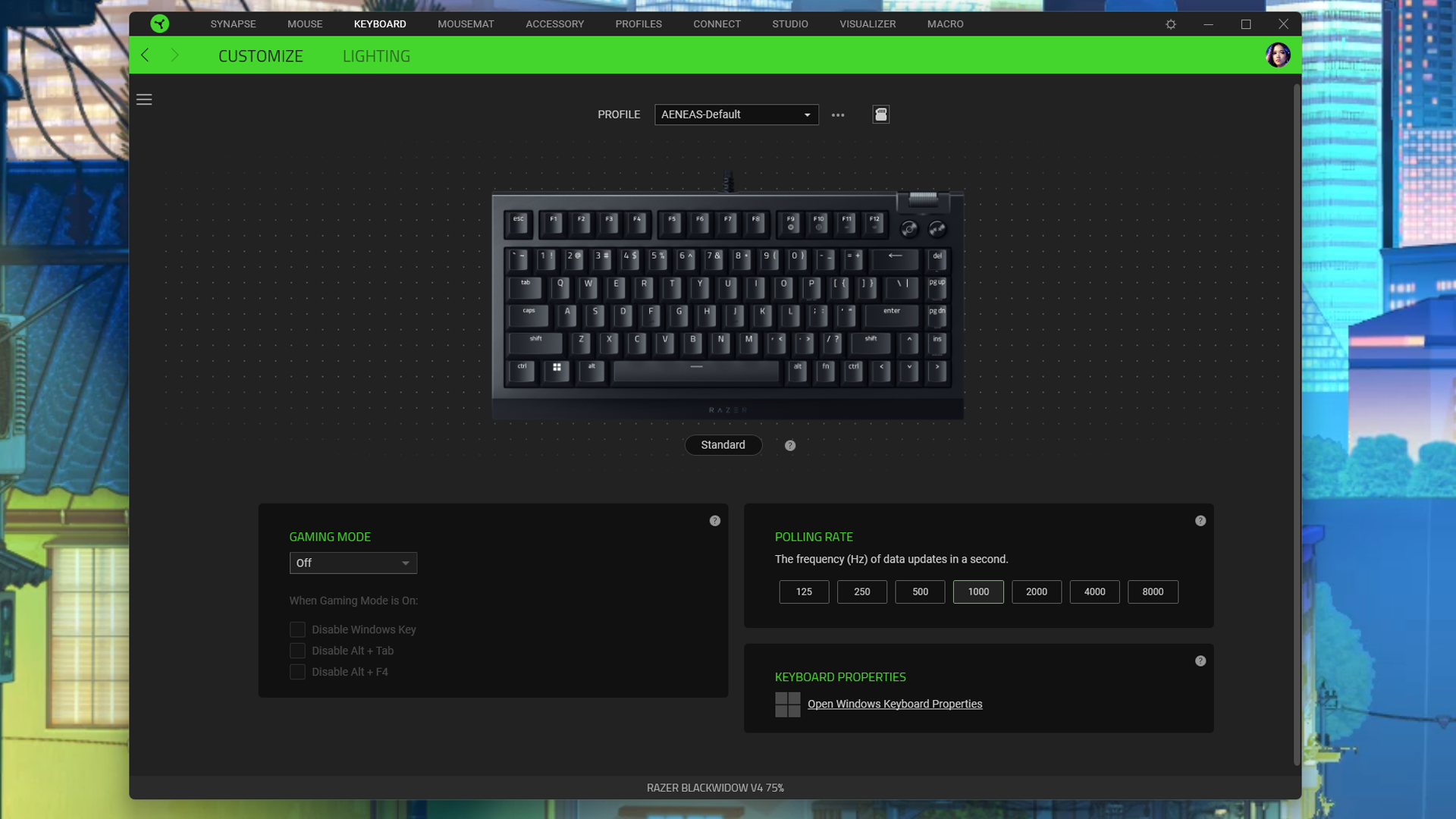
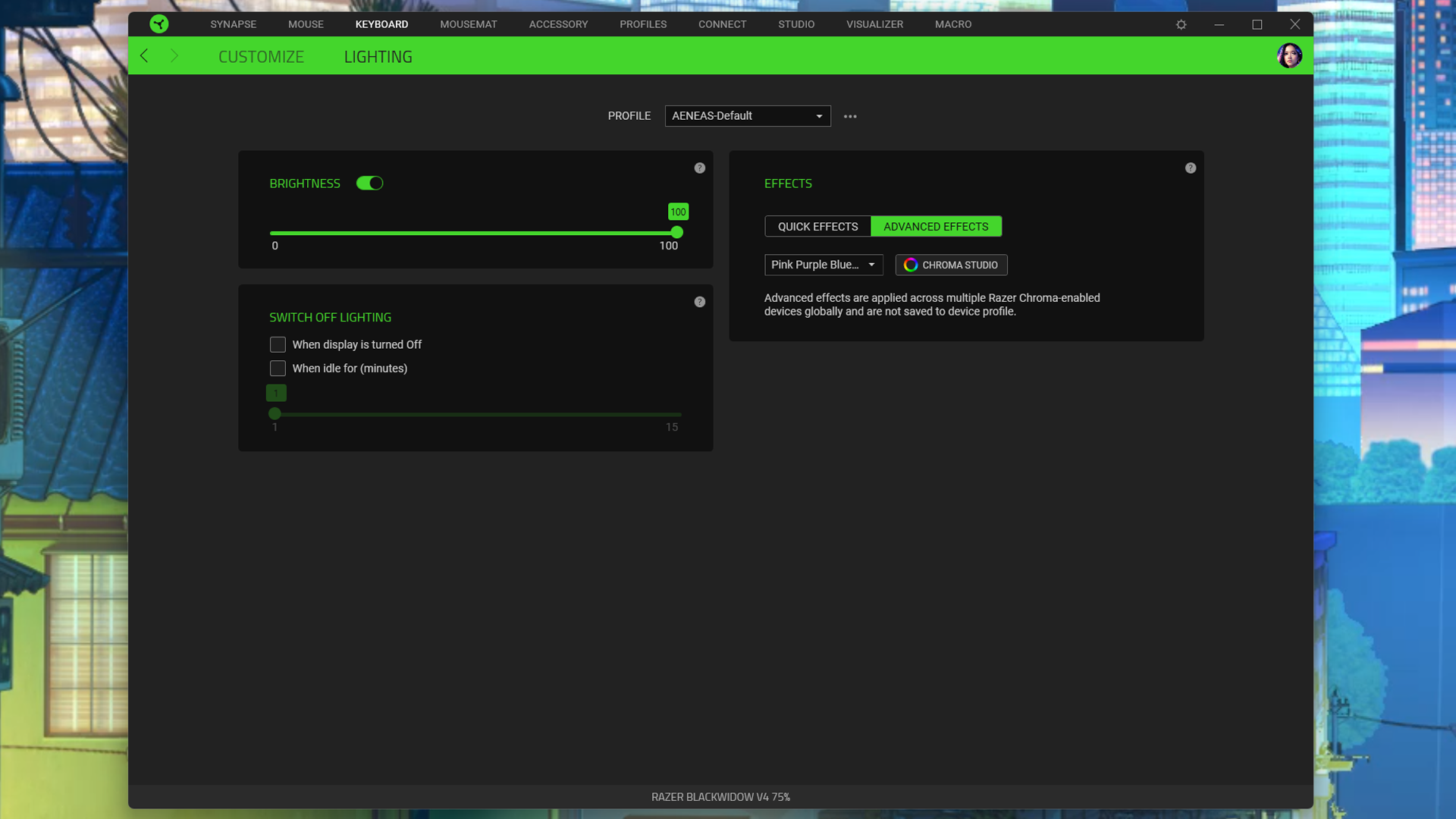
You can use Synapse 3 to remap keys (two layers, thanks to Razer’s “HyperShift” duplication tech), adjust the polling rate, and configure the keyboard’s per-key RGB and side underglow, either with preset quick effects or using Razer’s unnecessarily advanced Chroma Studio. As I mentioned earlier, the media keys are sort of programmable — you can program the roller (up/down) and the mute key (single press only), but you cannot program the play/pause key.
It’s a little strange that you can’t at least program the same number of layers for the mute key as exist on the play/pause key, but perhaps Razer will update that in one of its future hourly Synapse 3 updates.
The Bottom Line
The BlackWidow V4 75% is a pretty solid offering for Razer’s first hot-swappable keyboard, but it’s far from perfect. I’m a little disappointed that it looks so... boring, considering it’s Razer’s foray into a new category — the chunky black on black on black just isn’t doing it for me. Also, while it is fairly (physically) customizable once you get your hands on it, it’s disappointing that it’s not being offered with different switch options, or with different keycap options (Razer doesn’t make its PBT keycaps in a 75-percent layout and doesn’t plan to at the moment), and that the white version is more expensive (I know it’s only $10, but still).
But for $189.99, it’s one of the better-sounding gaming keyboards you’ll find. I’m personally a bigger fan of the Asus ROG Strix Scope II 96 Wireless’ (also $179.99) sound, but if you’re looking for something smaller than an almost-full-size keyboard, the BlackWidow V4 75% is a good choice.
MORE: Best Gaming Keyboards
MORE: How to Pick Keycaps for Your Mechanical Keyboard
MORE: How to Build a Custom Mechanical Keyboard

Sarah Jacobsson Purewal is a senior editor at Tom's Hardware covering peripherals, software, and custom builds. You can find more of her work in PCWorld, Macworld, TechHive, CNET, Gizmodo, Tom's Guide, PC Gamer, Men's Health, Men's Fitness, SHAPE, Cosmopolitan, and just about everywhere else.
-
gg83 omg. i just got the razer mini keyboard or whatever its called. but this has the lighting around the sides!!!!!!!!!!! and you can replace the keys and caps!!!?>???? good on ya razer. only thing is i need to log into the stupid app to run rgb.Reply
